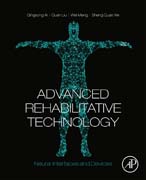
Advanced Rehabilitative Technology: Neural Interfaces and Devices
Xie, Shane Shengquan
Meng Lee, Wei
Advanced Rehabilitative Technology teaches readers how to: (i) acquire and process bio-signals using biosensors and acquisition devices; (ii) identify the human movement intention and decode the brain signal; (iii) design physiological and musculoskeletal models and establish the neural interfaces; and (iv) develop neural devices and control them efficiently using biological signals. If you are new to this field, this book clearly and concisely lays out the background, state of the art as well as the most recent work in this field. It takes a multidisciplinary theme between the engineering and medical field. This book will includes four sections to solve four key problems in neural interfaces and devices; (i) neuromuscular/brain signal processing; (ii) human motion and intention recognition; (iii) biomechanics modelling and interfaces; and (iv) neural devices and control for rehabilitation. Each chapter goes through a detailed description of the bio-mechatronic systems used and then the implementation and testing to show how it fulfils the needs of that specific area of rehabilitation. It details new neural interfaces and devices, some of which have never been published before in any journals or conferences. With this book, you will be able to get up to speed on the most recent and future advancements in bio-mechatronics engineering as well as in the rehabilitation field . The author team has over 20 years' experience in neurological systems, bio-mechatronics and rehabilitation engineering; this book presents their insights into emerging technologies and developments that are being or will be utilized in biological systems and mechatronics for rehabilitative purposes.. Gives a comprehensive background of biological interfaces and details of new advances in the field.. Addresses the challenges of rehabilitative applications in areas of bio-signal processing, bio-modelling, neural and muscular interface, and neural devices. Each chapter provides substantial background materials and relevant case studies to each subject INDICE: Chapter 1 Introduction. In this chapter, the biological systems, neural interfaces and devices for rehabilitation will be introduced; motivation of this book will be clarified.Chapter 2 State of the Art. In this chapter, the recent development of neuromuscular and brain rehab will be investigated. The modelling and interfacing technologies of the existing research will be reviewed and support the motivation of our work.Chapter 3 Neuromuscular Signal Acquisition and Pre-Processing. In this chapter, the neuro activation principle, bio-sensing and acquisition devices will be developed. The most recent EMG signal pre-processing methods will be presented as well.Chapter 4 EMG-Based Motion Recognition. In this chapter, the motor-related EMG feature extraction and motion recognition methods for body movement rehabilitation will be investigated. Both hand gesture and gait identification strategy will be studied.Chapter 5 Brain Signal Acquisition and Pre-Processing. In this chapter, various EEG signals such as SSVEP and P300 will be analysed. The bio-sensors and acquisition devices as well as processing methods for brain activity monitoring will be presented.Chapter 6 EEG-Based Brain Intention Recognition. In this chapter, the collected EEG signals will be used to decode human brain intention. A series of processing methods will be proposed to achieve accurate recognition of the SSVEP and hybrid EEG signal.Chapter 7 Neuromuscular Modelling. In this chapter, a musculoskeletal model will be developed on the basis of biological organisms and physiological analysis. The EMG-driven musculoskeletal model will be established for interactive rehabilitation.Chapter 8 Neural Interfaces. In this chapter, the neuromuscular interface and brain computer interface will be developed and can be applied to human robot interactive control. The modelling and application of the interfaces robot will be discussed.Chapter 9 Neural Devices. In this chapter, a variety of neural devices such as robotic arm and neural keyboard will be designed and developed to verify the bio-interfaces and explore the application of this study for rehabilitation purpose.Chapter 10 Conclusion. In this chapter, the main contributions and conclusion of this book will be conducted. Current limitations and future trends will also be discussed
- ISBN: 978-0-12-814597-5
- Editorial: Academic Press
- Encuadernacion: Rústica
- Páginas: 280
- Fecha Publicación: 01/10/2018
- Nº Volúmenes: 1
- Idioma: Inglés
